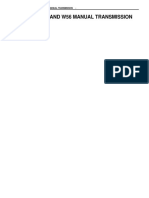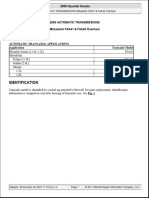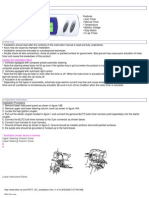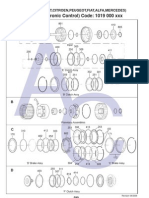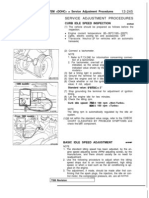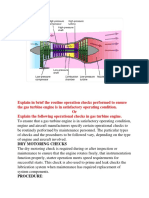Stall Test
Stall Test
Uploaded by
Teddy TjCopyright:
Available Formats
Stall Test
Stall Test
Uploaded by
Teddy TjOriginal Description:
Original Title
Copyright
Available Formats
Share this document
Did you find this document useful?
Is this content inappropriate?
Copyright:
Available Formats
Stall Test
Stall Test
Uploaded by
Teddy TjCopyright:
Available Formats
STALL TEST
AUTOMATIC TRANSMISSION
5. Stall Test
A: INSPECTION
NOTE: The stall test is of extreme importance in diagnosing the condition of the automatic transmission and the engine. It should be conducted to measure the engine stall speeds in R and 2 ranges. Purposes of the stall test: To check the operation of the automatic transmission clutch. To check the operation of the torque converter clutch. To check engine performance. 1) Check that throttle valve opens fully. 2) Check that engine oil level is correct. 3) Check that coolant level is correct. 4) Check that ATF level is correct. 5) Check that differential gear oil level is correct. 6) Increase ATF temperature to 70 to 80C (158 to 176F) by idling the engine for approx. 30 minutes (with select lever set to N or P). 7) Place the wheel chocks at the front and rear of all wheels and engage the parking brake. 8) Move the manual linkage to ensure it operates properly, and shift the select lever to the 2 range. 9) While forcibly depressing the foot brake pedal, gradually depress the accelerator pedal until the engine operates at full throttle.
10) When the engine speed is stabilized, record that speed quickly and release the accelerator pedal. 11) Shift the select lever to N range, and cool down the engine by idling it for more than one minute. 12) If the stall speed in 2 range is higher than specifications, low clutch slipping and 2-4 brake slipping may occur. To identify it, conduct the same test as above in R range. 13) Perform the stall tests with the select lever in D range. NOTE: Do not continue the stall test for MORE THAN 5 SECONDS at a time (from closed throttle, fully open throttle to stall speed reading). Failure to follow this instruction causes the engine oil and ATF to deteriorate and the clutch and brake to be adversely affected. Be sure to cool down the engine for at least 1 minute after each stall test with the select lever set in the P or N range and with the idle speed lower than 1,200 rpm. If the stall speed is higher than the specified range, attempt to finish the stall test in as short a time as possible, in order to prevent the automatic transmission from sustaining damage. Stall speed (at sea level): 2.0 L Turbo model: 2,600 3,400 rpm 2.5 L Non-turbo model: 2,100 2,600 rpm
P R N D 3 2 1
(A)
(B) AT-00449
(A) Brake pedal (B) Accelerator pedal Stall speed (at sea level) Less than specifications Position 2, R Cause Throttle valve not fully open Erroneous engine operation Torque converter clutch's one-way clutch slipping Line pressure too low Low clutch slipping One-way clutch malfunction Line pressure too low Reverse clutch slipping Low & reverse brake slipping Line pressure too low Low clutch slipping 2-4 brake slipping
Greater than specifications
4AT-32
You might also like
- User - Manual - Rally - Caja de CambiosDocument116 pagesUser - Manual - Rally - Caja de CambiosoliverjavieramadorNo ratings yet
- 105 Series Overhaul - HF1ADocument83 pages105 Series Overhaul - HF1ABruno ParenteNo ratings yet
- Volvo TP 31397-1 IgnitionDocument108 pagesVolvo TP 31397-1 Ignitionvanapeer100% (9)
- Manual de Carroceria para Camiones HINO Linea 300 XZU Y XKU PDFDocument277 pagesManual de Carroceria para Camiones HINO Linea 300 XZU Y XKU PDFjhon jairo90% (10)
- Yamaha Gp1200 Owners ManualDocument3 pagesYamaha Gp1200 Owners ManualGregoryNo ratings yet
- Torque Converter Stall TestDocument3 pagesTorque Converter Stall TestMilorad ZelenovicNo ratings yet
- W55 and W56 Manual TransmissionDocument2 pagesW55 and W56 Manual TransmissionFrancisca De pazNo ratings yet
- tp99124 PDFDocument20 pagestp99124 PDFDieselkNo ratings yet
- 60-72 Chevy TruckDocument150 pages60-72 Chevy Trucktruckshop100% (5)
- Automatic Transmission Control System 1. GeneralDocument16 pagesAutomatic Transmission Control System 1. Generalbob loblaw100% (1)
- Planetary Gear Unit 1. Construction: Chassis - A340E, A340F, A343E and A343F Automatic Transmissions CH-14Document5 pagesPlanetary Gear Unit 1. Construction: Chassis - A340E, A340F, A343E and A343F Automatic Transmissions CH-14Maxi SardiNo ratings yet
- Automatic Transaxle (A540h) - Rav4 Sxa1Document23 pagesAutomatic Transaxle (A540h) - Rav4 Sxa1Christian Linares Abreu100% (1)
- Transmission Fluid PDFDocument5 pagesTransmission Fluid PDFLv2mack0% (1)
- A43 PDFDocument126 pagesA43 PDFyermain100% (1)
- Installation Instructions: Nissan KA24DE Cylinder Head Kit Part Number 11061233Document7 pagesInstallation Instructions: Nissan KA24DE Cylinder Head Kit Part Number 11061233prosper shumbaNo ratings yet
- Transmission Troubleshooting GuideDocument8 pagesTransmission Troubleshooting GuidewiinstantrepairNo ratings yet
- Accent Eps DTC 1290-2Document5 pagesAccent Eps DTC 1290-2Steeven RodriguezNo ratings yet
- Auto Mat Ice Trans - Auto Trans F ComponentsDocument4 pagesAuto Mat Ice Trans - Auto Trans F Componentstonek9No ratings yet
- At TCM VistoDocument283 pagesAt TCM Vistosyahrul pratama (UL)No ratings yet
- Jatco Products eDocument13 pagesJatco Products ehttps://smart69.ru/0% (1)
- Thermal Oil-Level Sensor: Technical InformationDocument2 pagesThermal Oil-Level Sensor: Technical InformationРадослав БошковNo ratings yet
- Toyota Timing ChainDocument96 pagesToyota Timing ChainkikanaNo ratings yet
- 4f27e Parte 1Document5 pages4f27e Parte 1libertyplusNo ratings yet
- Attn 0205 AjDocument35 pagesAttn 0205 AjRheezal DanuNo ratings yet
- WS ATF Level Adjustment For U660E/F Transmissions: Drivetrain Autom I TR Nsmi !TR Le USADocument11 pagesWS ATF Level Adjustment For U660E/F Transmissions: Drivetrain Autom I TR Nsmi !TR Le USAAlex Maceira GraterolNo ratings yet
- Differential Carrier: ComponentsDocument16 pagesDifferential Carrier: Componentspriyankar007No ratings yet
- Technical Service Bulletin: Automatic Transmission DTC P0880/P088000Document11 pagesTechnical Service Bulletin: Automatic Transmission DTC P0880/P088000anoNo ratings yet
- G4a El FallasDocument8 pagesG4a El FallasLogam Lopez100% (1)
- If Your Vehicle Needs To Be Towed: 5-1. Essential InformationDocument7 pagesIf Your Vehicle Needs To Be Towed: 5-1. Essential InformationxsmartieNo ratings yet
- 4x4 Flashing Lights PajeroDocument12 pages4x4 Flashing Lights PajeroTawanda NyakupindaNo ratings yet
- TestingDocument39 pagesTestingHaji RashidNo ratings yet
- AWTF80SC / 81SC (AF21/AF40-6) AWTF80SC / 81SC (AF21/AF40-6) : FWD 6 Speed FWD 6 SpeedDocument1 pageAWTF80SC / 81SC (AF21/AF40-6) AWTF80SC / 81SC (AF21/AF40-6) : FWD 6 Speed FWD 6 SpeedFSR1407No ratings yet
- General Troubleshooting: Possible Cause Remedy ProblemDocument2 pagesGeneral Troubleshooting: Possible Cause Remedy ProblemMayobanex Moya Martinez100% (1)
- F4a41 F4a42Document83 pagesF4a41 F4a42Derek Cisneros Leon100% (1)
- RollersDocument18 pagesRollersPallavi PankajakshiNo ratings yet
- Manual Pajero4x4steereingDocument42 pagesManual Pajero4x4steereingGIAN CARLO MAMANI GILES.No ratings yet
- GF4EATDocument112 pagesGF4EATVENDA DE PEÇAS CAMBIONo ratings yet
- 11005d1137975747 Diy Check Automatic Transmission Fluid Level 05tundratranoperDocument5 pages11005d1137975747 Diy Check Automatic Transmission Fluid Level 05tundratranoperJimmy Zegarra100% (1)
- Comprobaciones en Hilux 2KD Sintoma Perdida de Potencia.Document18 pagesComprobaciones en Hilux 2KD Sintoma Perdida de Potencia.Norman Valle SáenzNo ratings yet
- Index: T H M 4 4 0 - T 4Document104 pagesIndex: T H M 4 4 0 - T 4Anonymous eExWojLxNo ratings yet
- Toyota Camry ATF Fluid Exchange MergedDocument18 pagesToyota Camry ATF Fluid Exchange MergedKhoa NguyenNo ratings yet
- Blitz FATT DC InstallationDocument4 pagesBlitz FATT DC InstallationDave_BNo ratings yet
- ZF 4 HP 20Document4 pagesZF 4 HP 20Irina VeresininaNo ratings yet
- 840 TransmisionsDocument19 pages840 TransmisionskaesarNo ratings yet
- Vehicles 6-Speed PowerShift Transmission DPS6 DescriptionDocument3 pagesVehicles 6-Speed PowerShift Transmission DPS6 DescriptionCarlos SerapioNo ratings yet
- Re5r05a Catalogo Peçs PDFDocument4 pagesRe5r05a Catalogo Peçs PDFNayara Alcântara Lima SilvaNo ratings yet
- 55 Mazda 1 F3A PDFDocument8 pages55 Mazda 1 F3A PDFAlexander Neyra0% (1)
- F3a PDFDocument3 pagesF3a PDFWalter Escobar Silgado50% (2)
- Turbine Speed Sensor Removal (TB-50LS) : 1. Preliminary and Post Procedures 1. Preliminary ProceduresDocument17 pagesTurbine Speed Sensor Removal (TB-50LS) : 1. Preliminary and Post Procedures 1. Preliminary ProceduresPatricio ValenciaNo ratings yet
- LSD Manual PDFDocument13 pagesLSD Manual PDFHector Muñoz SepulvedaNo ratings yet
- A4cf0 Kiahyundai P0731Document2 pagesA4cf0 Kiahyundai P0731Huỳnh Minh Đức100% (1)
- 6T40-Vac Test LocationsDocument4 pages6T40-Vac Test LocationsMauricio Exequiel ChavezNo ratings yet
- YARIS Manual PDFDocument20 pagesYARIS Manual PDFPatrick MasseyNo ratings yet
- An Overview of The Engine Control Unit (ECU) and Its Sensors For The Mitsubishi 4G93 EngineDocument6 pagesAn Overview of The Engine Control Unit (ECU) and Its Sensors For The Mitsubishi 4G93 EngineSyahiratul Nadiah MoktarNo ratings yet
- Adjustment: 1. Inspect Park/Neutral Position Switch AssyDocument50 pagesAdjustment: 1. Inspect Park/Neutral Position Switch AssyRobert VargasNo ratings yet
- RE4F04Document81 pagesRE4F04Derek Cisneros LeonNo ratings yet
- Master Solenoid Kit: MS KM-175Document1 pageMaster Solenoid Kit: MS KM-175Guilherme ZoboliNo ratings yet
- Sonnax 77701-076-InDocument2 pagesSonnax 77701-076-InmiguelNo ratings yet
- Attention: U140E, U140F & U241E Installation GuideDocument2 pagesAttention: U140E, U140F & U241E Installation GuideDerek Cisneros LeonNo ratings yet
- 31 Appendix H Readiness Tests Drive Patterns ExamplesDocument15 pages31 Appendix H Readiness Tests Drive Patterns ExamplespapipapiiNo ratings yet
- Transmission Fluid Change Procedure - Hyundai Service ManualDocument3 pagesTransmission Fluid Change Procedure - Hyundai Service Manualnagy.klaudiuNo ratings yet
- Title Minyak EnjinDocument8 pagesTitle Minyak EnjinKhairul SyahreelNo ratings yet
- 1G FUEL SYSTEM (DOHC) - Service Adjustment ProceduresDocument40 pages1G FUEL SYSTEM (DOHC) - Service Adjustment ProceduresAgus Prasetyanto100% (1)
- Important Question For AEMRDocument4 pagesImportant Question For AEMRNambi RajanNo ratings yet
- Oil Pump (Bus) Mercedes OM 926 LA: (Europa) (Engine)Document4 pagesOil Pump (Bus) Mercedes OM 926 LA: (Europa) (Engine)Karthii AjuNo ratings yet
- M. Trzesniowski - Rennwagentechnik - Grundlagen, Konstruktion, Komponenten, Systeme - 1. Auflage (1) - 444-491Document48 pagesM. Trzesniowski - Rennwagentechnik - Grundlagen, Konstruktion, Komponenten, Systeme - 1. Auflage (1) - 444-491adhiprachNo ratings yet
- Chieftain TankDocument28 pagesChieftain TankTate100% (1)
- E Brochure Touring SportDocument2 pagesE Brochure Touring SportJose TomNo ratings yet
- Metrado de Madera EdificioDocument128 pagesMetrado de Madera EdificioAlberto Falconi TapiaNo ratings yet
- Emission Control: Exhaust Emissions Are Produced by Cars, Buses, andDocument10 pagesEmission Control: Exhaust Emissions Are Produced by Cars, Buses, andsonabrar10100% (1)
- DEUTZDocument1 pageDEUTZALEXANDER ROSARIO ACEVEDONo ratings yet
- Abs DTCDocument118 pagesAbs DTCDenCom DzNo ratings yet
- Car Rental TariffsDocument3 pagesCar Rental TariffsajajaNo ratings yet
- VOLVO BP (Public) Serving Traning-1Document204 pagesVOLVO BP (Public) Serving Traning-1kogyi.tty987No ratings yet
- Optimal Energy Management of A Dual-Motor Electric Vehicle Using Dynamic ProgrammingDocument6 pagesOptimal Energy Management of A Dual-Motor Electric Vehicle Using Dynamic Programmingquang caoNo ratings yet
- Operating Instructions: Directive 94/9/EC Apparatus Group II Zone 1/2 Apparatus Class 2G Linde Tractor P60ZDocument70 pagesOperating Instructions: Directive 94/9/EC Apparatus Group II Zone 1/2 Apparatus Class 2G Linde Tractor P60ZVasile VrabieNo ratings yet
- Chotia-460 NewManualDocument8 pagesChotia-460 NewManualErin LassleyNo ratings yet
- GASKET PDocument75 pagesGASKET Pmvv-sspNo ratings yet
- Siemens Sge 2mwDocument2 pagesSiemens Sge 2mwmohsen_cumminsNo ratings yet
- Rebel E NewDocument29 pagesRebel E NewJansen SebastianNo ratings yet
- Massey Ferguson MF 1150 Tractor Service Parts Catalogue ManualDocument15 pagesMassey Ferguson MF 1150 Tractor Service Parts Catalogue Manualqlb898316No ratings yet
- Liebherr-Overview of Icons and Operating Elements LRT 1090-2.1LRT 1100-2.1Document9 pagesLiebherr-Overview of Icons and Operating Elements LRT 1090-2.1LRT 1100-2.1Dreyfus W van HeerdenNo ratings yet
- Toyota 2Document33 pagesToyota 2Andi WidodoNo ratings yet
- Filter Overview With Service Intervals and Capacities: 6M Final Tier 4 (FT4) Series Row-Crop Tractors - 6145MDocument2 pagesFilter Overview With Service Intervals and Capacities: 6M Final Tier 4 (FT4) Series Row-Crop Tractors - 6145Mrobert dbcNo ratings yet
- Intimidator Utv Owners ManualDocument104 pagesIntimidator Utv Owners ManualClyde FairbanksNo ratings yet
- Alfa Romeo 164 - Group 12 - ClutchDocument14 pagesAlfa Romeo 164 - Group 12 - ClutchtecnoincNo ratings yet
- d10r - Akt HosesDocument43 pagesd10r - Akt Hosesleaw81100% (1)
- L32BDocument1 pageL32BМ РNo ratings yet
- LAND ROVER DEFENDER No.1132460 DamagedDocument1 pageLAND ROVER DEFENDER No.1132460 DamagedthekingsamsaadNo ratings yet
- KTM RC 125 Price Statement Review AvailabilityDocument1 pageKTM RC 125 Price Statement Review AvailabilityUMAR KIBRIYANo ratings yet






